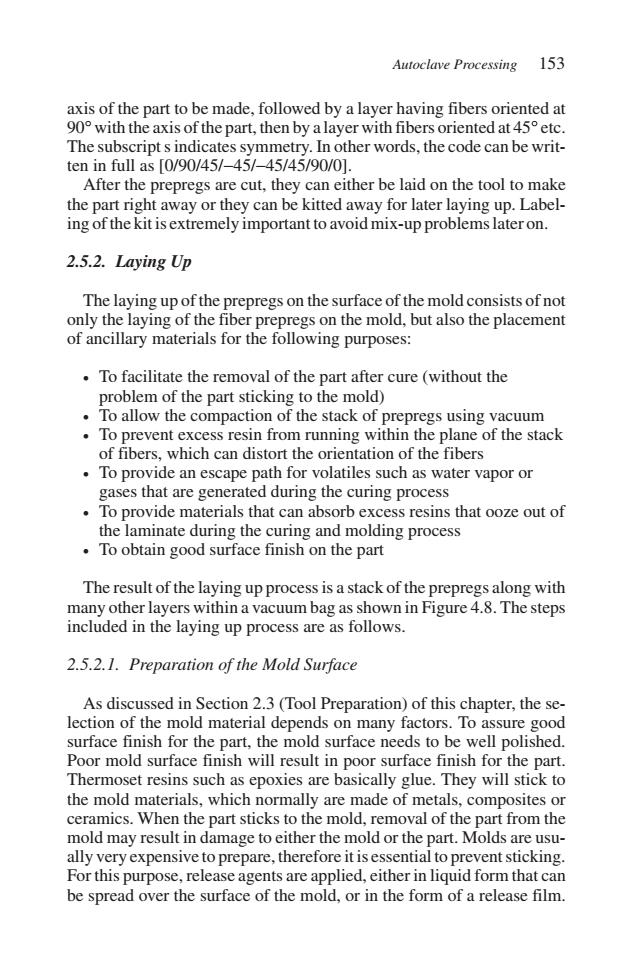正在加载图片...

Autoclave Processing 153 axis of the part to be made,followed by a layer having fibers oriented at 90 with the axis of the part,then by alayer with fibers oriented at 45etc. The subscript s indicates symmetry.In other words,the code can be writ- ten in full as[0/90/45/-45/-45/45/90/0]. After the prepregs are cut,they can either be laid on the tool to make the part right away or they can be kitted away for later laying up.Label- ing of the kit is extremely important to avoid mix-up problems later on. 2.5.2.Laying Up The laying up of the prepregs on the surface of the mold consists of not only the laying of the fiber prepregs on the mold,but also the placement of ancillary materials for the following purposes: To facilitate the removal of the part after cure(without the problem of the part sticking to the mold) To allow the compaction of the stack of prepregs using vacuum To prevent excess resin from running within the plane of the stack of fibers,which can distort the orientation of the fibers To provide an escape path for volatiles such as water vapor or gases that are generated during the curing process To provide materials that can absorb excess resins that ooze out of the laminate during the curing and molding process To obtain good surface finish on the part The result of the laying up process is a stack of the prepregs along with many other layers within a vacuum bag as shown in Figure 4.8.The steps included in the laying up process are as follows. 2.5.2.1.Preparation of the Mold Surface As discussed in Section 2.3(Tool Preparation)of this chapter,the se- lection of the mold material depends on many factors.To assure good surface finish for the part,the mold surface needs to be well polished. Poor mold surface finish will result in poor surface finish for the part. Thermoset resins such as epoxies are basically glue.They will stick to the mold materials,which normally are made of metals,composites or ceramics.When the part sticks to the mold,removal of the part from the mold may result in damage to either the mold or the part.Molds are usu- ally very expensive to prepare,therefore it is essential to prevent sticking. For this purpose,release agents are applied,either in liquid form that can be spread over the surface of the mold,or in the form of a release film.axis of the part to be made, followed by a layer having fibers oriented at 90° with the axis of the part, then by a layer with fibers oriented at 45° etc. The subscript s indicates symmetry. In other words, the code can be written in full as [0/90/45/−45/−45/45/90/0]. After the prepregs are cut, they can either be laid on the tool to make the part right away or they can be kitted away for later laying up. Labeling of the kit is extremely important to avoid mix-up problems later on. 2.5.2. Laying Up The laying up of the prepregs on the surface of the mold consists of not only the laying of the fiber prepregs on the mold, but also the placement of ancillary materials for the following purposes: • To facilitate the removal of the part after cure (without the problem of the part sticking to the mold) • To allow the compaction of the stack of prepregs using vacuum • To prevent excess resin from running within the plane of the stack of fibers, which can distort the orientation of the fibers • To provide an escape path for volatiles such as water vapor or gases that are generated during the curing process • To provide materials that can absorb excess resins that ooze out of the laminate during the curing and molding process • To obtain good surface finish on the part The result of the laying up process is a stack of the prepregs along with many other layers within a vacuum bag as shown in Figure 4.8. The steps included in the laying up process are as follows. 2.5.2.1. Preparation of the Mold Surface As discussed in Section 2.3 (Tool Preparation) of this chapter, the selection of the mold material depends on many factors. To assure good surface finish for the part, the mold surface needs to be well polished. Poor mold surface finish will result in poor surface finish for the part. Thermoset resins such as epoxies are basically glue. They will stick to the mold materials, which normally are made of metals, composites or ceramics. When the part sticks to the mold, removal of the part from the mold may result in damage to either the mold or the part. Molds are usually very expensive to prepare, therefore it is essential to prevent sticking. For this purpose, release agents are applied, either in liquid form that can be spread over the surface of the mold, or in the form of a release film. Autoclave Processing 153